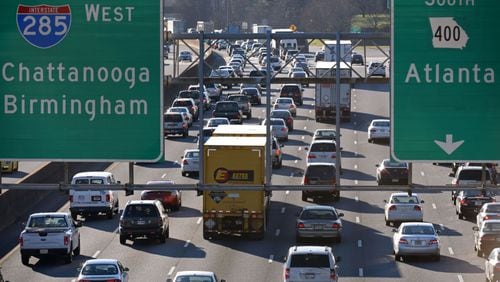New I-285/Ga. 400 interchange at a glance
Major construction begins: February 2017
Construction ends: Mid-2020
Details: The project will improve 4.3 miles of I-285 from west of Roswell Road to east of Ashford Dunwoody Road and 6.2 miles along Ga. 400 from the Glenridge Connector to Spalding Drive. It includes new flyover ramps and collector-distributor lanes along both highways. It also includes a new diverging diamond interchange on Ga. 400 at Abernathy Road and a new bridge at Mt. Vernon Road.
More information: www.dot.ga.gov
Much of the work will be done at night and on weekends to avoid making rush hour worse. New lanes will open as old ones close to keep traffic moving. Public transportation and private shuttles may tempt some commuters off the road.
But don’t kid yourself. When work begins on a new I-285 interchange at Ga. 400, it will make commuting worse for hundreds of thousands of drivers who travel one of the most congested stretches of highway in the country.
The work won’t begin in earnest until after the holidays. But on Thursday Gov. Nathan Deal and other dignitaries officially launched one of the biggest highway construction projects in Georgia history.
» GDOT animation of the rebuilt interchange
The reconstruction of the I-285/Ga. 400 interchange will take more than three years and cost $800 million. When it’s done in 2020, commuters will get back some of the precious hours they spend idling in traffic on the northern Perimeter and surrounding area.
But commuting is going to get worse before it gets better.
“Get ready to see lots more cones,” said Georgia Department of Transportation Commissioner Russell McMurry of what now rivals the phoenix as the symbol of Atlanta: the orange construction cone. McMurry was speaking at Thursday’s ceremony in the King Building in Sandy Springs, overlooking the interchange.
The project is part of a 10-year, $10 billion overhaul of Georgia roads, bridges and highways designed to get commuters and freight moving. Last year the General Assembly approved a gas tax increase and other new revenue to pay for it.
Among the other projects included in the plan: new I-285 interchanges at I-20 east and west of Atlanta, new Ga. 400 express lanes from I-285 to McGinnis Ferry Road and truck-only lanes on northbound I-75 from McDonough to I-475.
State Transportation Board member Mark Burkhalter likened the initiative to the Chicago Cubs winning this year’s World Series.
“They may have won the World Series of baseball,” he said at Thursday’s ceremony. “But I think Georgia has won the World Series of investing in infrastructure.”
The new I-285/Ga. 400 interchange shows just how badly some of the work is needed. The current interchange — call it Dysfunction Junction — was designed to handle 100,000 vehicles a day. But 420,000 vehicles now pass through daily. McMurry said the rebuilt interchange will save the average commuter eight hours a year spent in traffic.
Utility and other minor work has already begun, but major construction will begin in late January or early February. The new interchange will feature “flyover” ramps and new lanes adjacent to both highways. The project also includes a new diverging-diamond interchange at Ga. 400 and Abernathy Road and a new bridge at Mount Vernon Road.
When it’s done, the new interchange will be almost as big as Spaghetti Junction, where I-285 meets I-85 northeast of Atlanta.
Traffic congestion will worsen during construction, which almost always causes bottlenecks. And when the new Atlanta Braves stadium opens at I-285 and I-75 next year, traffic on the Perimeter is expected to be even worse on game days.
McMurry said GDOT will try to keep traffic hassles to a minimum during construction. Much of the work will be done at night and on weekends.
He said new lanes will be opened to traffic when existing lanes must be closed. And some of the early work – including the new interchange at Abernathy Road – will improve traffic sooner rather than later.
McMurry said GDOT also is working with MARTA, the Georgia Regional Transportation Authority and the Perimeter Community Improvement District to encourage people who work in the area to use public transportation or private shuttles provided by local employers.
“You don’t have to be stuck in traffic,” he said.
But for those who are, he pledged, “we’re going to do everything we can to keep traffic moving.”
About the Author



/cloudfront-us-east-1.images.arcpublishing.com/ajc/P7DYBH6TO7FEKG4SUXQQKADRXE.jpg)



